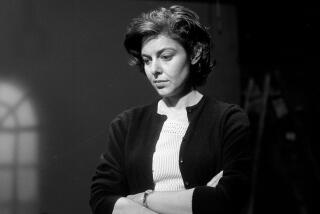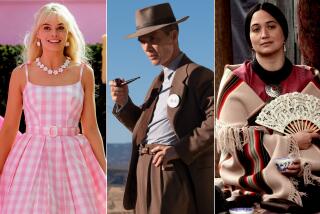Coleen Gray dies at 92; actress made mark as ‘good girl’ of film noir
Film noir actress Coleen Gray, who generally played the “good girl” in hard-boiled films such as “The Killing,” “Nightmare Alley” and “Kansas City Confidential” before segueing into a prolific television career, died Monday at her home in Bel-Air. She was 92.
The death was from natural causes, said family friend David Schecter.
Gray appeared in a variety of films in the 1940s and 1950s, including the Howard Hawks classic western “Red River” opposite John Wayne and Frank Capra’s “Riding High” with Bing Crosby.
But it was in the noir genre that she made her mark, though she didn’t get the memorable femme fatale parts that went to such actresses as Audrey Totter and Lizabeth Scott. Gray was more likely to be cast as the woman who struggled in vain to keep the man she loved from going down a dark path.
“When I started out, I wanted to be a sex goddess,” Gray said in a 1999 Los Angeles magazine interview. “But I guess I was the wholesome type.”
That was never more true than in Stanley Kubrick’s “The Killing” (1956), a gritty heist film in which she played the fiancee of Sterling Hayden, an ex-con planning a big-time race track robbery. She dreads that it will go wrong (and it does, spectacularly) but can’t leave him.
“I’m no good for anybody else,” Gray tells him. “I’m not pretty and I’m not very smart, so please don’t leave me alone anymore.”
Co-star Marie Windsor played a scheming gold-digger to whom Hayden says, “You got a great big dollar sign there where most women have a heart.”
Gray looked upon the Windsor role with envy. “I was the good girl,” she told the New York Times in 1999. “It was frustrating! And Marie had the big fat juicy part.”
But Gray’s typecasting was somewhat a reflection of who she was in real life.
“As an actress, I was never secure,” Gray said in a videotaped interview for the Film Noir Foundation. “I studied so hard so I wouldn’t mess up on a line, flub my lines. To flub lines, to me, was an acute disgrace.
“To do anything wrong, to make a wrong move or do anything other than what I was instructed to do.... I had a fear of screwing up.”
She was born Doris Bernice Jensen on Oct. 23, 1922 in Staplehurst, Neb. She moved with her family to Hutchinson, Minn., where, in seventh grade, the teacher asked students what they wanted to be when they grew up.
“Most of the girls wanted to be a housewife, a nurse, a teacher or a secretary,” Gray said in a 2007 Santa Fe New Mexican interview. “When it came to my turn, I said, ‘I want to be a movie star.’ And they all laughed. Oh, did they laugh!”
After earning a bachelor of arts degree from Hamline University in St. Paul, Minn., Gray took a bus to La Jolla, where her then-fiance was stationed. Eventually moving to Los Angeles, she worked a variety of jobs and joined a theater group headed by Carl Heins Roth, who had been an assistant to famed director Max Reinhardt in Vienna. An agent spotted her in a play at the theater and took her to Fox studios, where she was eventually placed under contract.
She changed her name to Coleen, with an unusual spelling to help it stand out, and Gray in tribute to Betty Grable.
As her noir roles waned in the 1950s, Gray did a handful of science fiction and horror movies, including the “The Leech Woman” (1960) in which she definitely played the bad girl. In the cheapie film, which has become a cult favorite, Gray’s character kills men to extract fluid from them that she needs to stay young.
“I think we shot that thing in five days,” Gray said in an interview for the book “Confessions of a Scream Queen.”
“It was so corny, but we all had such fun with it.”
By then she was working in television. Gray appeared in early live TV dramas, and went on to guest spots on “Maverick,” “Rawhide,” “77 Sunset Strip,” “Perry Mason” and many others.
She was married three times. Gray and her third husband, Joseph “Fritz” Zeiser, were involved in a prison ministry organization founded in the 1970s by Charles Colson. Zeiser died in 2012.
Gray is survived by her son Bruce Bidlack; daughter Susan Amateau; stepsons Rick and Steve Zeiser; 10 grandchildren and four great-grandchildren.
More to Read
Start your day right
Sign up for Essential California for the L.A. Times biggest news, features and recommendations in your inbox six days a week.
You may occasionally receive promotional content from the Los Angeles Times.







